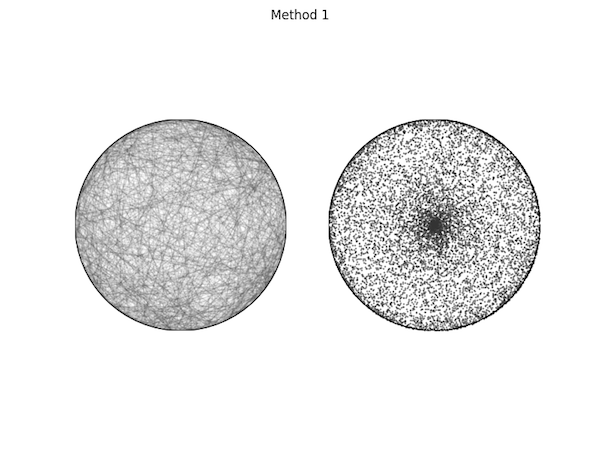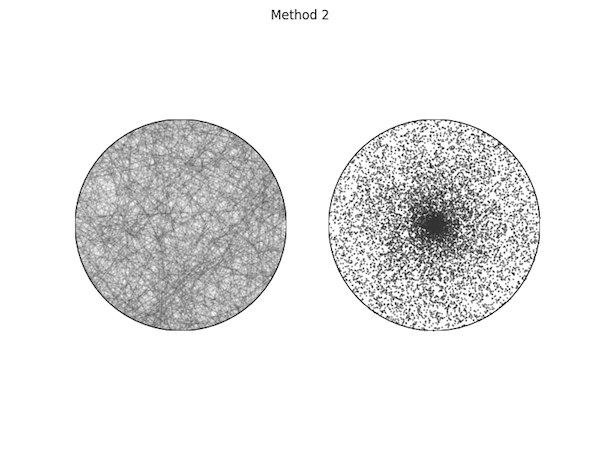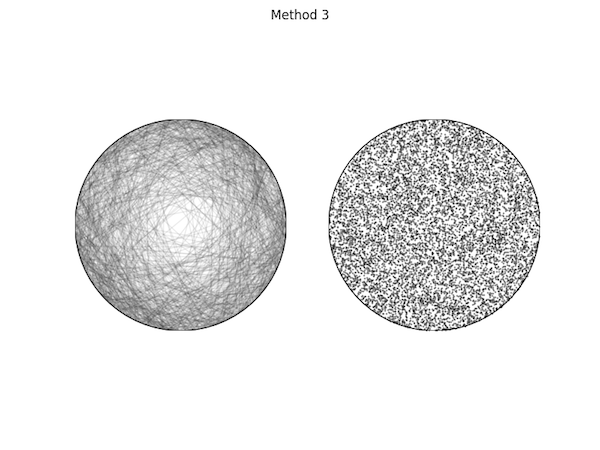Bertrand's Paradox
Posted on 17 April 2018
Bertrand's Paradox is an illustration of the need to define the mechanism for picking a random variable carefully for its associated probability to be well-defined.
Consider an equilateral triangle inscribed in a circle. What is the probability that a randomly-chosen chord of the circle is longer than the side-length of the triangle?
It turns out that the answer depends on how the randomly-chosen chord is selected. There are (at least) three reasonable ways to choose a chord randomly, briefly outlined below (see the Wikipedia article for more details).
Method 1. (Random endpoints) Pick two random points on the circumference of the circle and join them with a straight line. The probability that the chord thus formed is longer than the side of the triangle is then $\frac{1}{3}$.
Method 2. (Random radius) Pick a random radius of the circle and then a random point on the radius. Construct the unique chord through the point, perpendicular to the radius. In this case, the probability that the chord is longer than the triangle side length is $\frac{1}{2}$.
Method 3. (Random midpoint) Pick a point inside the circle at random and take this to be the midpoint of the chord perpendicular to the radius containing it. The probability that this chord is longer than the triangle side length is then $\frac{1}{4}$.
The code below visualizes a random selection of chords (lefthand side) and their midpoints (righthand side) chosen according to each of these methods and verifies the probabilities given above.



Typical output:
Bertrand, method 1 probability: 0.3328
Bertrand, method 2 probability: 0.5053
Bertrand, method 3 probability: 0.2506
This code is also available on my Github page.
import numpy as np
import matplotlib.pyplot as plt
from matplotlib.patches import Circle
from matplotlib.lines import Line2D
TAU = 2 * np.pi
# Fractional RGB values for light grey.
GREY = (0.2,0.2,0.2)
# Don't plot more than this number of chords because they overlap too much
# and obscure the point we're trying to make.
NCHORDS_TO_PLOT = 1000
# Do the statistics using a sample size of nchords
nchords = 10000
# The circle radius. Doesn't matter what it is.
r = 1
# The critical side length of the equilateral triangle inscribed in the circle.
# We are testing if a chord is longer than this length.
tlen = r * np.sqrt(3)
def setup_axes():
"""Set up the two Axes with the circle and correct limits, aspect."""
fig, axes = plt.subplots(nrows=1, ncols=2, subplot_kw={'aspect': 'equal'})
for ax in axes:
circle = Circle((0,0), r, facecolor='none')
ax.add_artist(circle)
ax.set_xlim((-r,r))
ax.set_ylim((-r,r))
ax.axis('off')
return fig, axes
def bertrand1():
"""Generate random chords and midpoints using "Method 1".
Pairs of (uniformly-distributed) random points on the unit circle are
selected and joined as chords.
"""
angles = np.random.random((nchords,2)) * TAU
chords = np.array((r * np.cos(angles), r * np.sin(angles)))
chords = np.swapaxes(chords, 0, 1)
# The midpoints of the chords
midpoints = np.mean(chords, axis=2).T
return chords, midpoints
def get_chords_from_midpoints(midpoints):
"""Return the chords with the provided midpoints.
Methods 2 and 3 share this code for retrieving the chord end points from
the midpoints.
"""
# We should probably watch out for the edge-case of a "vertical" chord
# (y0=0), but it's rather unlikely over 10000 trials, so don't bother.
chords = np.zeros((nchords, 2, 2))
for i, (x0, y0) in enumerate(midpoints.T):
m = -x0/y0
c = y0 + x0**2/y0
A, B, C = m**2 + 1, 2*m*c, c**2 - r**2
d = np.sqrt(B**2 - 4*A*C)
x = np.array( ((-B + d), (-B - d))) / 2 / A
y = m*x + c
chords[i] = (x, y)
return chords
def bertrand2():
"""Generate random chords and midpoints using "Method 2".
First select a random radius of the circle, and then choose a point
at random (uniformly-distributed) on this radius to be the midpoint of
the chosed chord.
"""
angles = np.random.random(nchords) * TAU
radii = np.random.random(nchords) * r
midpoints = np.array((radii * np.cos(angles), radii * np.sin(angles)))
chords = get_chords_from_midpoints(midpoints)
return chords, midpoints
def bertrand3():
"""Generate random chords and midpoints using "Method 3".
Select a point at random (uniformly distributed) within the circle, and
consider this point to be the midpoint of the chosed chord.
"""
# To ensure the points are uniformly distributed within the circle we
# need to weight the radial distance by the square root of the random
# number chosen on (0,1]: there should be a greater probability for points
# further out from the centre, where there is more room for them.
angles = np.random.random(nchords) * TAU
radii = np.sqrt(np.random.random(nchords)) * r
midpoints = np.array((radii * np.cos(angles), radii * np.sin(angles)))
chords = get_chords_from_midpoints(midpoints)
return chords, midpoints
bertrand_methods = {1: bertrand1, 2: bertrand2, 3: bertrand3}
def plot_bertrand(method_number):
# Plot the chords and their midpoints on separate Axes for the selected
# method of picking a chord randomly.
chords, midpoints = bertrand_methods[method_number]()
# Here's where we will keep track of which chords are longer than tlen
success = [False] * nchords
fig, axes = setup_axes()
for i, chord in enumerate(chords):
x, y = chord
if np.hypot(x[0]-x[1], y[0]-y[1]) > tlen:
success[i] = True
if i < NCHORDS_TO_PLOT:
line = Line2D(*chord, color=GREY, alpha=0.1)
axes[0].add_line(line)
axes[1].scatter(*midpoints, s=0.2, color=GREY)
fig.suptitle('Method {}'.format(method_number))
prob = np.sum(success)/nchords
print('Bertrand, method {} probability: {}'.format(method_number, prob))
plt.savefig('bertrand{}.png'.format(method_number))
plt.show()
plot_bertrand(1)
plot_bertrand(2)
plot_bertrand(3)
References
- J. Bertrand, Calcul des probabilit?es, Gauthier-Villars, Paris, pp. 4–5 (1889).
- E. T. Jaynes, "The well-posed problem", Foundations of Physics, 3, 477–493 (1973).
- A. Drory, "Failure and Uses of Jaynes' Principle of Transformation Groups", Foundations of Physics, 45, 439–460 (2015). arXiv